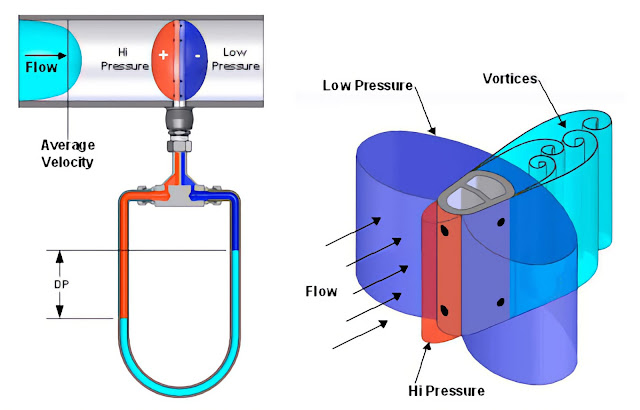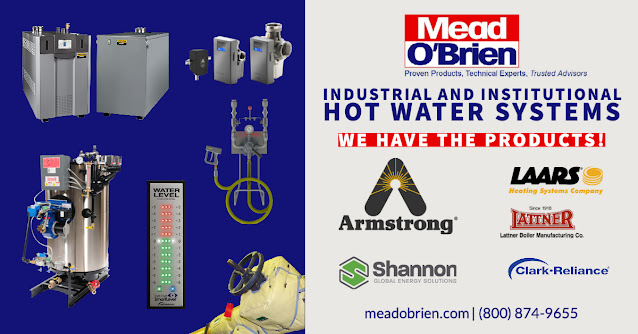Providing problem solving and educational information for topics related to industrial steam, hot water systems, industrial valves, valve automation, HVAC, and process automation. Have a question? Give us a call at (800) 892-2769 | www.meadobrien.com
The Armstrong VERIS Verabar®
Mead O'Brien Is Your Preferred Source for Institutional and Industrial Hot Water Systems and Equipment
With their manufacturer partners Armstrong International, Lattner Boiler Manufacturing, Shannon Global Energy Solutions, Clark Reliance, and Laars Heating Systems, Mead O'Brien supplies complete equipment packages - including pumps, storage tanks, piping, condensate & steam traps, valves, level instruments, computerized control systems, and high-efficiency insulation. Mead O'Brien's expertise covers heating systems of any capacity.
Mead O'Brien will also assist you in analyzing, designing, and installing boiler efficiency solutions with various fuel options that will reduce energy consumption and greenhouse gas emissions.
Mead O'Brien will professionally and expertly assist you with:
- Commercial projects where the mechanical design takes advantage of a boiler's high turndown and condensing design for optimum hot water efficiency.
- Commercial heating projects where hot water temperatures are to be above 160°F.
- Industrial process applications that require high-pressure hot water.
- Vertical Tubeless Boilers
- Horizontal Firetube Boilers
- Low-NOx Boilers
- Electric Boilers
- Steam Trap Surveys
- Thermal Assessments
- Hot Water System Surveys
Contact Mead O'Brien today to learn more. Call (800) 892-2769 or visit https://meadobrien.com.
Inflatable Seat Butterfly Valves - Posi-flate
The Posi-flate Inflatable Seat Butterfly Valve uses air pressure to inflate the seat against the disc and create a bubble-tight seal, resulting in minimal friction as the disc opens and closes. The Posi-flate inflatable seat automatically compensates for wear, providing longer valve life.
The resilient seated butterfly valve forces the disc into the static seat, causing impingement between the disc and seat, resulting in excessive damage, premature wear, and valve leakage.
The Posi-flate inflatable seated butterfly valve offers less friction, low torque, less wear, and longer valve life!
Unlike other valves that seal with friction, Posi-flate's unique butterfly valve uses an inflatable seat to seal with air pressure. Thus it requires less torque and a smaller actuator, resulting in lower overall valve cost. Plus, the seat automatically compensates for wear, providing longer valve life.
How Posi-flate Butterfly Valves Work
Closed, unsealed
As the valve rotates into the closed position, the disc makes only casual contact with the seat, reducing friction, wear, and torque requirements.
Closed, sealed
After the valve is closed, the seat inflates against the disc providing more sealing surface and an even pressure distribution against the disc.
Open, unsealed
Before the valve opens, the seat deflates. The disc is then free to rotate to the open position.
Posi-flate inflatable seated butterfly valve applications include:
- Material Control and Cut-Off Valve Applications
- Double Dump Valve Assembly Applications
- Dryer Valve Applications
- Outlet Valve Applications
- Pneumatic Conveying Valve Applications
- Vacuum Valve Applications
For more information about Posi-flate inflatable disc butterfly valves, contact Mead O'Brien at (800) 892-2769 or visit http://www.meadobrien.com.
Benchmarking Energy Consumption of Equipment and Facilities
Note: The following post discusses energy consumption and benchmarking in general. As you'll see, the most significant component of plant energy consumption is typically process heating/steam consumption. Mead O'Brien, along with products and technologies from Armstrong International, Shannon Global Energy Solutions and Everactive, has the people, equipment, and experience to assist you in developing a strategy to significantly improve your plant steam and hot water systems conservation efforts. Contact Mead O'Brien for more information.
While each manufacturing facility and production process is unique, every industry uses similar equipment. Most facilities' major energy consumers concentrate energy use on a few basic systems: lighting, process heating, steam generation, compressed air, pumping, and fans. Making a list of Significant Energy Users (SEUs) can assist in focusing efforts on projects that will result in the most significant savings.
To create a list of SEUs, group equipment by location, type, or process, and record information such as estimated operating hours, rated power, and loading. The diagram below depicts the various systems and equipment that consume energy in a typical plant and the differences in potential energy savings between facility systems.
The 80/20 rule applies here. Eighty percent of energy consumption is accounted for by 20 percent of the equipment or processes. Only a few energy systems typically consume most of the energy at a site. Consider concentrating your efforts on these systems.
Comparing facilities, processes, or equipment over time is the baseline. Benchmarking: Comparing the energy performance of facilities, techniques, or equipment over time to similar internal or external facilities.
Benchmarking the performance of your SEUs is a great place to start on your energy-saving journey. If you work in a multi-facility organization, you can use benchmarking to compare facilities and combine the results to identify best practices. Even if you only have one facility, benchmarking against similar equipment within your facility allows you to identify areas for improvement and best practices of your own.
Benchmarking can include practices such as understanding, comparing, and optimizing maintenance measures and equipment energy use (such as boiler blowdown or compressed air leaks).
Benchmarking your energy data allows manufacturers to compare their equipment, process, or facility to others and identify potential energy savings opportunities. Benchmarking understands how you currently operate (for example, how much energy your plant or a single SEU uses) and compares that to similar operations.
Benchmarking internally (comparing similar steam boilers in the same facility), company-wide (comparing air compressors in different facilities), industry-wide (information from surveys, trade groups, etc.), or all three. Benchmarking can be intimidating for many small manufacturers because, unlike your larger industry peers, you don't have a large pool of plants, manufacturing lines, and heavy equipment for a fair comparison. However, even the smallest manufacturers must compare their major energy users to best practices.
Energy savings occur in systems such as compressed air, steam generation/distribution, or process heating. Determine the types of energy resources used by each piece of machinery or process. A paint booth, for example, will use compressed air to spray the paint, exhaust fans, and process heating to cure the painted product. This activity will aid in the identification of individual energy-consuming systems and their supporting equipment.
Small or medium-sized manufacturers may lack a large energy team, a large budget, or the resources to conduct large-scale energy audits or significant equipment overhauls. Turning to outside experts can be extremely helpful provide proven expertise all for reasonable costs.
Call a Mead O'Brien steam/hot water efficiency expert to help you establish your energy conservation plan.
(800) 874-9655
A Commitment to Sustainability Starts With A Strong Value System and A Principled Approach to Doing Business
Mead O'Brien Mission
Carbon footprint reduction, increased throughput, and safety is our goal.
- Benchmarking Energy Consumption
- Analytical Measurements for Steam or Hot Water Generation
- Use of Instrumentation to Increase Throughput
- Use of Instrumentation to Increase Safety
- Control Environmental Leakage Rates Through Valves
- Optimize Valve Selection & Automation for Reliability
- Applications of Appropriate Safety Approvals Such as FM, API, NFPA, ANSI
- Valve Assembly and Testing Documentation












